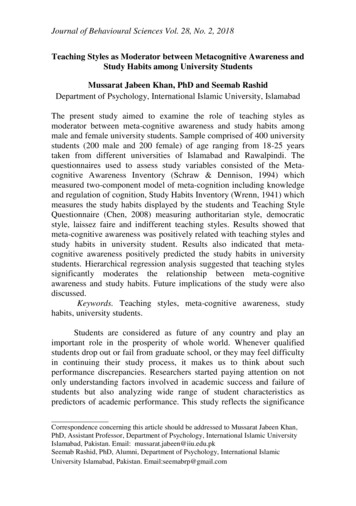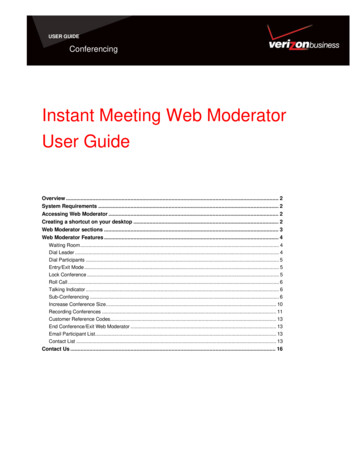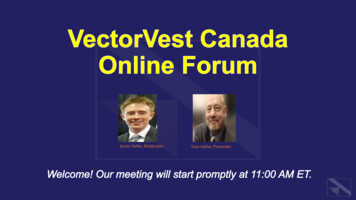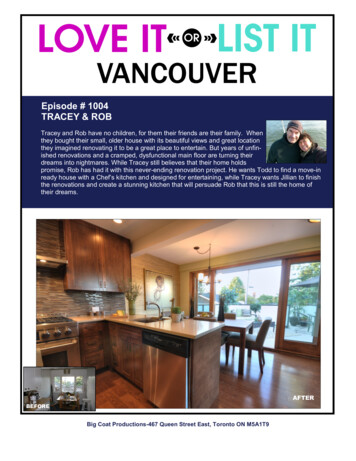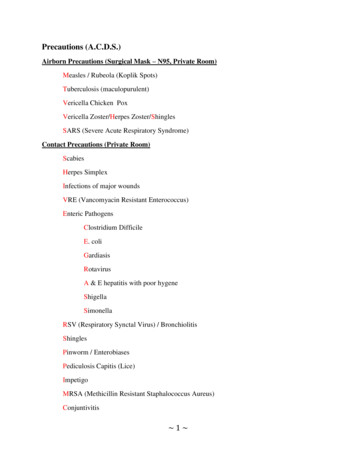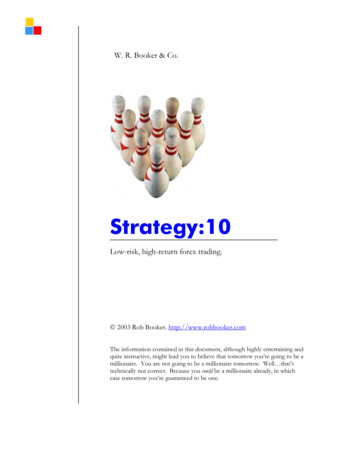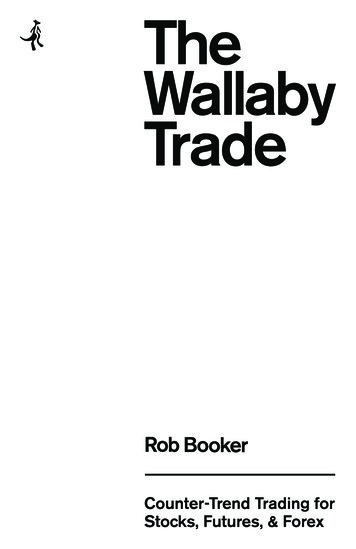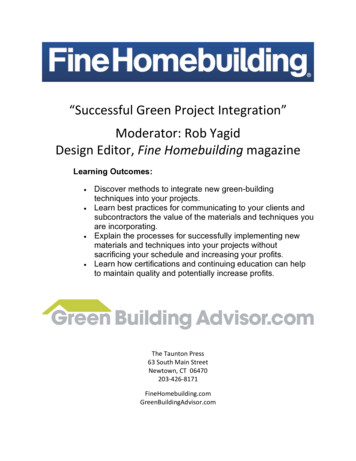
Transcription
ng Outcomes: Discover methods to integrate new green-buildingtechniques into your projects.Learn best practices for communicating to your clients andsubcontractors the value of the materials and techniques youare incorporating.Explain the processes for successfully implementing newmaterials and techniques into your projects withoutsacrificing your schedule and increasing your profits.Learn how certifications and continuing education can helpto maintain quality and potentially increase 06470203- ‐426- m
PanelistsFernandoPagésRuiz,writer/builderFernando is a frequent contributor to Fine Homebuilding magazine and is the author of Building the AffordableHouse: Trade Secrets for High-Value, Low-Cost Construction (The Taunton Press, 2005) and Affordable Remodel(The Taunton Press, 2007). He has developed, built, and remodeled homes in California, Nebraska, and Wyoming,and has won a number of awards, including recognition from the National Association of Home derMichael Chandler has been designing and building high-performance homes since 1978. Michael volunteered withthe NAHB Research Center to help create the ICC-700 National Green Building Standard and also worked with hislocal HBA – DOC to establish their Green Building Council and implement a credible third-party certificationprocess. He writes for Fine Homebuilding magazine and GreenBuildingAdvisor.com, and teaches the CGP andMCGP courses for the NAHB University of Housing. Michael is an 11-year member of NAHB Builder TwentyProgram. He holds plumbing and general-contractor licenses and Certified Graduate Builder, Certified GreenProfessional, Master CGP, and Spike designations. In 2012, Michael earned the distinction of NAHB Master GreenProfessional of the Year, and his company received the award for NAHB Green Project of the Year—Single nored to be named the National Association of Home Builders' Green Builder Advocate of the year, Don has apassion for sustainable construction that has been coursing through his veins since the early '80s. Representing thethird generation of the Ferrier Companies, Don is no stranger to construction. He is a true visionary of energyefficiency and sustainable construction techniques, and he travels across the U.S. educating and guiding thosewithin the industry and beyond on their inherent benefits.FerrierCustomHomes.com
IncorporatingIncorporatingBest PracticesHow the best builders adopt new materials and building techniquesPages Ruiz and Rob YagidBy Fernando PagÉsto boost quality and profitsBest practices loosely describe themethods used to create a well-builthouse, the definition of which hasexpanded greatly over the past 30years. Energy performance, indoor-air quality, and locally sourced materials with lowembodied energy have sidled up to qualitycraftsmanship and good design as the hallmarks of a great home.Such attributes haven’t always been a priority in mainstream home design and construction. Our current housing stock and theway new homes are built are being considered more carefully by the mass market thanever before. As a result, the demand for better built, more energy-efficient housing is onthe rise; clients expect architects and buildersto deliver. For many builders who want tomeet that demand, expand their business, orsimply build to a higher standard, questionsremain: How do we get there, and how dowe do it successfully?Changing the way you build to keep pacewith industry-accepted best practices, whichcan differ from code, can be challenging.Whether you’re simply altering the way youflash windows, choosing to use a new sidingmaterial, or opting to incorporate SIPs intoyour next project, the tasks can be daunting.To get better insight into how to adopt a different way of building, we talked to some ofthe most progressive, successful builders andarchitects in the country. They shed light onthe importance of education, the need to ensure accuracy and quality on the job site, andthe methods of effectively managing the riskof changing the way they work in an ultracompetitive, cost-conservative ate yourselfEvery builder’s journey toward best practices requires an education, on the job or inwww.finehomebuilding.comdecember 2011/january 201261
Fiveelements of successwere builders producing a large volume of homes, while others were remodelers with far fewer clients. Most, however,attributed their success to the same five elements. We asked a few of those builders to elaborate on each point. Thesestrategies can help to improve the quality of the homes you build and the vitality of your business.1ProvideConsistentOversightHow we do it: To us, over-Name: MarkKlein and JimMcKnightCompany:Gimme ShelterConstructionLocation:Amherst, Wis.Years inindustry: 2462The businesses of those we interviewed varied in scale and focus. Somesight does not mean micromanagement. Instead, oversightmeans paying attention to thedaily tasks that our crews andsubcontractors are engagedin—a perspective that has beencritical in ensuring success inour projects and developmentin a self-directed, empoweredstaff. We have daily contact withour lead guys and usually areon site ourselves at least oncea week, depending on whatphase of the job we’re on. Froma designer/builder perspective,these site meetings give us andthe crew a chance to go overconstruction methods that arebased on our experience andperformance goals. The visitsalso help to communicate howour design decisions evolvedand offer an important opportunity for the crew to share experiences with our techniques, to offer feedback, andto share alternatives that maybe more practical. Our practicehas always been built on a twosided conversation.In some instances, such as thepreinsulation, air-sealing stage,we have a checklist based onour past project successes andfailures. Otherwise, we dependon the communication amongeveryone involved in the project. This is a communicationbusiness, and success usuallyfollows clear communication.Things that go badly are oftenthe result of not making surethat everyone is informed.FINE HOMEBUILDINGthe classroom. “Best practices are not forgiving,” says Tom Wade,co-owner of Artistic Homes in Albuquerque, N.M. Wade admits tosome serious errors in his learning process, and he sums up his recommendation for any contractor wanting to become a better builderin four words: “Go back to school.” Fortunately, many formal andinformal opportunities for continued learning exist.Many of the builders we spoke with received their introduction andongoing education in best practices through trade organizations, suchas the National Association of Home Builders (NAHB), which provides formal courses and certifications like the two-day Green Building for Building Professionals course that helps builders to attain thepopular certified-green-professional (CGP) designation. Many builders also agreed that the real trial-by-fire education starts the day youdecide to build a certified home.Green-building certifications from organizations like NAHB,LEED for Homes, and Masco Environments for Living provide consumers with an objective guarantee of the energy and environmentalclaims builders make. The process also provides outreach and training for the trades. Being forced to meet certification criteria can be ahuge educational experience. For example, it might be a builder’s firsttime taking a hard look at the leakiness of his walls.Beyond more formal educational routes, all the builders we spokewith also have established a strong local network of experts and colleagues that they turn to regularly for insight and direction. Otherssimply tap into obvious but overlooked resources.Don Ferrier of Ferrier Custom Homes in Fort Worth, Texas, reliesheavily on suppliers when adopting a new material. “I think holistically, how a product or technique will affect the house as a whole, andthen go to a knowledgeable, trusted source to learn how to implementand install that feature properly,” he says. Ferrier was taught how towork with SIPs from his supplier early in his career and was thenable to educate his crews. He’s now known nationally for his highperformance, SIP-constructed homes.Dan Kolbert, a builder in Portland, Maine, attends monthly meetings with builders, carpenters, architects, engineers, energy auditors,and inspectors, who get together for “an informal discussion to ask,learn, debate, knock around, support, agonize over, ridicule, flog, andanswer the challenges and concepts of best building practices,” Kolbertsays, quoting the event invitation letter. “It’s crazy to struggle alone.”Educate those around you to ensure job-site qualityNo one builds a house alone, and the ideals of best practices areworthless if they can’t be implemented accurately and consistently.The best builders and architects have systems for managing work-“We discovered we had been making somemistakes. They weren’t expensive fixes,Drawing p. 61: Bruce Morser. Contributor drawings: Jackie Rogers.
2Establish a Network of Reliable EmployeesHow I do it: I don’t jump from supplier to supplierName: Don FerrierCompany: FerrierCustom HomesLocation: FortWorth, Texasor subcontractor to subcontractor chasing the cheapest bid. Instead, I spend a lot of my time establishingand maintaining long-term relationships with suppliers, crew members, and subcontractors. At first, noteveryone who works on our homes is versed in theway we work, but I find it important and beneficialto devote resources to training. For example, whenlooking for a new framer, I invite them to observe theassembly of one of our SIP homes. They might pick itup in about half a day, but I find they will usually beknowledgeable enough to complete a job themselvesafter working on roughly three homes with guidance.When specifying a new material that one of our subcontractors may not be familiar with, I take the timeto educate them. The best subs are those interestedin learning. For example, we have used QuickFlash(www.quickflashproducts.com) products for severalyears to seal all wall penetrations properly. On ourjobs, all subcontractors are responsible for flashingand sealing any wall penetration they make, which isnot how they normally operate. On their first project with us, I purchase the appropriate QuickFlashproduct and assist them in installing it correctly. Ialso bring out a can or two of expanding spray foamto seal for airtightness. On subsequent jobs for us,the subcontractor can include the flashing productand spray foam in their bid, and they know exactlyhow I want the plumbing, electrical, or HVAC penetration sealed.Years in industry: 27flow and the way the work is being done. For most, the managerialsegment of their business is driven by communication, organization,and an unrelenting commitment to getting the details right.Portland, Ore., architect Nathan Good begins most projects with ameeting of all those involved. The gathering usually takes place on aweekend at a local lumberyard, where the architect, general contractor, subcontractors, supplier reps, consultants, and building inspectorsare invited to meet. These small workshops begin with a messagefrom the homeowners, who are able to express to everyone involvedtheir hopes for the project and, when applicable, why they want ahome that may not be conventional. Everyone has the opportunity tovoice concerns, ask questions, talk, and learn from each other. Everyone shows up on site with clear, common goals.3Name: MichaelChandlerCompany: ChandlerDesign-BuildLocation:Mebane, N.C.Beyond hammering home lessons in the office, lumberyard, or conference hall, many builders simply strive to create job sites that fosteraccuracy. Patty McDaniel of Boardwalk Builders in Rehoboth Beach,Del., creates “a culture that embraces instructions,” she says. “Thelead carpenter and project managers have access to file boxes thatlive on site with all of the instruction manuals for each product in use.This way, training doesn’t have to be completely based on memoryrecall. If a problem comes up or a detail is questioned, they have theresource at hand to find a solution.”Similarly, Michael Chandler, a green builder based in North Carolina, says it was easier to keep an eye on his crew, to teach, and tocorrect when he worked as lead carpenter. As his business grew, however, Chandler could no longer watch as closely, and he learned theAnalyze the effectiveness of your workHow I do it: The difference between best practicesnow and back in the early 1980s comes down to thescience of measuring home performance: modelingperformance before construction, testing buildingassemblies during construction, and then verifyingthe performance after occupancy. I install advancedenergy-consumption tracking devices, such as theeMonitor by Power House Dynamics (www.powerhousedynamics.com), on our homes to see if they actually perform according to specifications. Whenthey don’t, I’m able to find out why. For example, I’mable to tell when a home’s hot-water solar collectorsstart cycling in the morning, how long they collectenergy, and when they shut down. In one instance,the monitoring system showed the collectors weren’tperforming as I’d hoped. I was able to discover thatthere was a poorly insulated thermistor on one paneland made the necessary fix. All the best practicesused to construct a quality home are theoretical if youcan’t determine how the home actually performs. It’sthe difference between tuning a car engine by ear andusing an advanced computer to do the work.Years in industry: 35but we wouldn’t have known about them if not for firsthand observation.”Pa u l E l d r e n k a
Fernando is a frequent contributor to Fine Homebuilding magazine and is the author of Building the Affordable House: Trade Secrets for High-Value, Low-Cost Construction (The Taunton Press, 2005) and Affordable Remodel (The Taunton Press, 2007). He has developed, built, and remodeled homes in California, Nebraska, and Wyoming, and has won a number of awards, including recognition from the .


